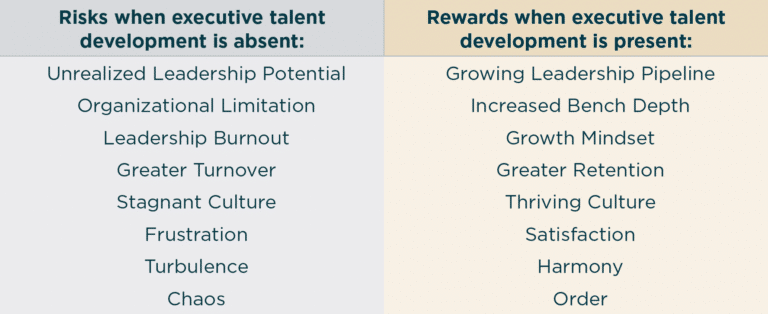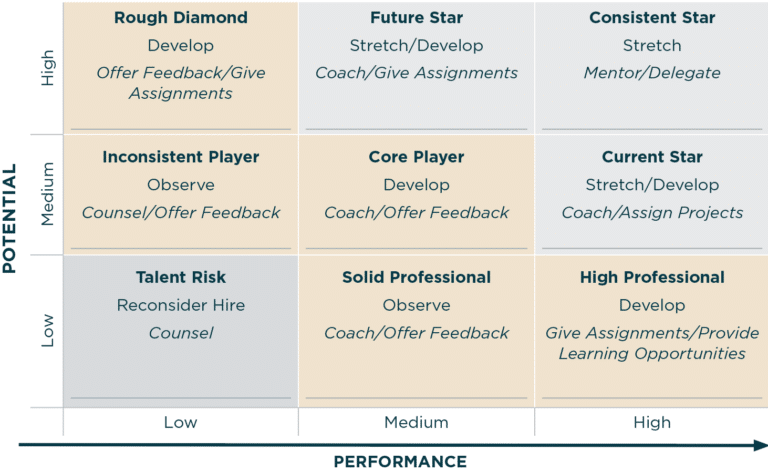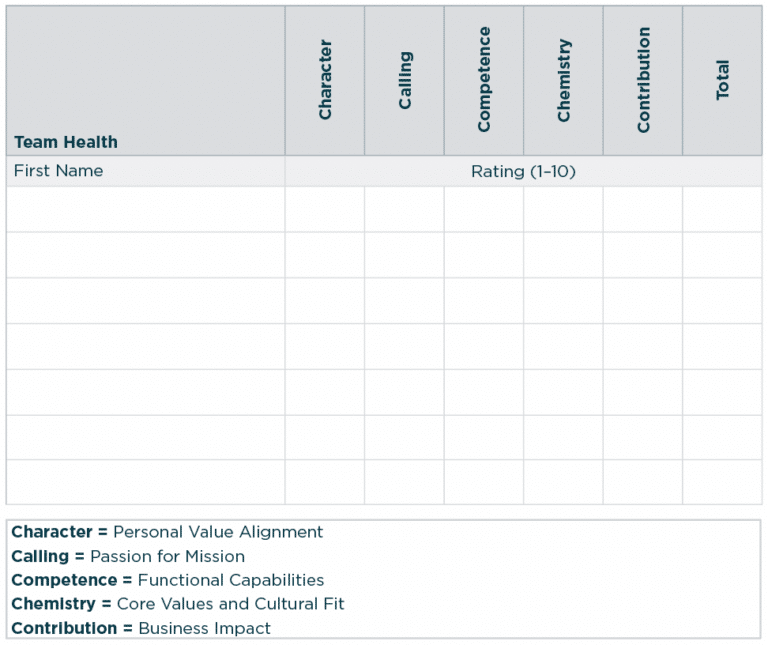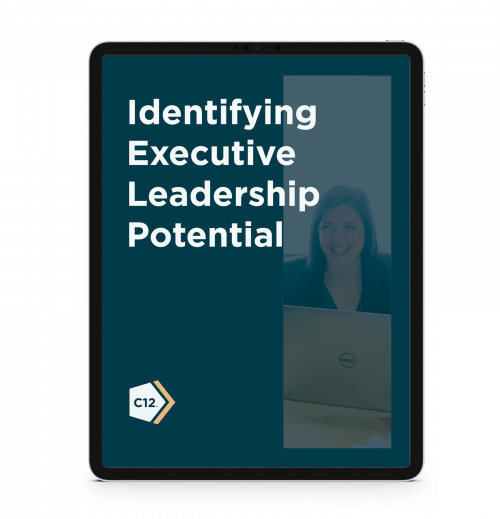Staff to C-Suite: How to Identify and Develop Executive Talent in Your Company – Part One
Discovering Leadership Potential in Your Employees
There is an urgent need in business today for leaders to identify leadership potential and to develop executive talent. Every day, 10,000 baby boomers reach retirement age, leaving a leadership vacuum in many companies. A recent TeamStage report showed that nearly 80% of companies report a leadership development gap, only 5% of organizations have fully implemented leadership development programs at all levels, and 42% of companies lack a leadership competency framework on which to base their development programs. A McKinsey & Company study found that 95% of employers believe their companies are inefficient in managing talented employees.

The need to identify leadership potential is as old as the Bible. In Exodus 18, Moses was handling all the disputes of the Israelites by himself, and he had reached a breaking point. Jethro, Moses’s father-in-law, saw this burden and intervened. He told Moses that what he was doing was “not good” and that the responsibility was “too heavy” for him alone. Jethro encouraged Moses to identify capable leaders and to establish a leadership hierarchy where smaller disputes could be handled by others.
This two-part article series will examine how to identify leadership potential and develop executive talent. This article will focus on the mechanics of leadership identification. Our next article will focus on leadership development methods.
The need to identify executive talent in your business has never been more urgent—but it will not happen on its own. You must carefully cultivate a leadership pipeline to prepare for future leadership needs in your business.
What Is Executive Talent Development?
Executive talent development is the process of identifying, cultivating, and preparing individuals for leadership roles.
It is a proactive process. Managers must take the lead both in identifying leaders with leadership potential and in creating development pathways to improve their competencies. When you cultivate a workplace culture where growth and learning are encouraged, you will be on your way toward building a robust leadership pipeline.
Executive talent development is crucial for all organizations:
To prepare the business to scale and grow. A capable executive leadership team allows your business to achieve healthy growth and take advantage of favorable market conditions.
To equip leaders for inevitable role changes. Investing in continuous leadership development will build a capable team that is growing along with the company.
To mitigate the complexities of succession planning. Developing a leadership pipeline of qualified leaders ensures that the organization has a pool of strong candidates.
These kinds of rewards make the affirmative case for developing executive talent. As employees grow in their leadership abilities, your company becomes more capable of handling business complexity and more resilient in the face of change.
On the other hand, those who neglect to invest in talent development face serious risks as the company’s leadership competence remains stagnant. A failure to address executive talent development may leave companies with a leadership vacuum should key leaders retire or decide to move on.

How to Identify Leadership Potential Inside Your Company
As you seek to develop your leadership pipeline, you must first consider your current talent pool. Look around your company. There are likely people who exhibit the potential to grow into the future leaders your company needs.
Talent assessment is both an art and a science. While you might be tempted to invest in people who exhibit high performance or those who are likable, these traits on their own do not necessarily indicate leadership potential. Sometimes, high performers are best if left to thrive in their current positions. Other times, leadership potential may be manifested in employees who are slightly disagreeable because they are willing to take unpopular contrarian positions.
Over the years, leaders in organizational development have developed tools to help business leaders identify leadership potential in their companies. We will explore the Nine-Box Talent Grid and the 5Cs assessment below.
Evaluate Performance and Potential with a Nine-Box Talent Grid

Start by looking at your current talent pool of talent for employees who exhibit both performance and potential:
Performance: Who can you depend on to get the job done? Who is admired for their productivity? Who is thriving in their current role? Who consistently hits their targets? Who consistently produces work with excellence? Who has demonstrated an ability to learn and take on increasingly complex projects? These are your high performers.
Potential: Who looks beyond their job to bigger issues and/or opportunities in the company? Who naturally takes on the role of a coach to help others succeed? Who fights for team health? Who exhibits maturity in tough situations and is cool under pressure? Who consistently makes good decisions? Who is willing to say the hard things that need to be said? These are your high potentials.
The Nine-Box Talent Grid is a tool used by senior leaders to assess their existing talent pool. Leaders will evaluate each employee on the x-axis to indicate their current level of performance and on the y-axis to indicate their current level of potential. Those who exhibit both performance and potential will end up in the top right quadrants of the grid. These are the employees you will want to invest in with an executive talent development opportunity.

Each of the nine boxes indicates different categories to identify the employee’s current leadership potential, along with suggested training methods to use with each one. You might invest in development opportunities for some employees and offer stretch opportunities for others.
It can be easy to mistake an employee’s current performance for their potential, but performance and potential do not always match one-to-one.
An individual who is performing well may not have the potential to serve in a leadership role, and someone with low to moderate performance may be underperforming because their true leadership gifts are not being realized. It is up to you as the leader to assess both performance and potential when you are considering providing someone with an executive talent development opportunity.
Determine Cultural Alignment with the 5Cs Assessment
Executive leaders determine the vision and direction for your company. They are the standard-bearers of your cultural values. Therefore, your future executives should be aligned and motivated by your company’s mission, passionate about your company’s vision, and committed to your core values.
Once you have identified an employee with high potential and performance, you must determine whether they exhibit alignment with your company culture.
The 5Cs assessment is a tool you can use to determine if a high-potential employee is a good fit for future leadership development. Each employee is ranked on a scale from one to ten according to the following characteristics:
- Character: To what extent does this person exemplify the qualities of a trustworthy and “Ideal Team Player”?
- Calling: To what extent does this person’s personal calling align with the mission of the company, the work they are doing at the company, and/or the work they are able to do outside of the job because of their work at the company?
- Competence: To what extent does this person contain the skills, gifting, and/or experience to fulfill what is required in the job?
- Chemistry: To what extent does this person exemplify each of your company’s core values, including alignment with your Business as a Ministry culture?
- Contribution: To what extent does this person positively impact the business? If this person were to leave, how much would the company be set back?

Download a C12 worksheet with both the Nine-Box Talent Grid and the 5Cs assessment to help you identify leadership potential in your company:
How to Recruit Executive Talent from Outside Your Company
Sometimes, your internal employees lack the capacity, skill set, or experience necessary for executive-level leadership. In those cases, you must recruit executive talent externally. Consider conducting an external search for talent if your company meets these conditions:
- You are experiencing rapid growth and need additional talent to support and sustain that growth
- You are looking to fill a specific role or skill set that is not currently represented
- You are in need of fresh perspectives or new ideas
- You are seeking to diversify the leadership team
An executive-level position is a critical hire for any company. While you may acutely feel the need to fill a vacant position, resist the temptation to quickly fill the role with the first person who exhibits the necessary skill set. The goal is to hire the best talent—and achieving this goal requires that you invest the time necessary to find the right person. Wise leaders will “hire slowly.”
Screen for Leadership Temperament. Include a screen for leadership temperament in your interview process. Consider using survey tools like the Culture Index, the Predictive Index, DiSC, Myers-Briggs, or the Enneagram to better understand the leadership style that you will be getting with your different candidates.
Screen for Cultural Fit. Consider using the 5Cs assessment in your interview process. Ask candidates questions to better understand how their personal vision and values align with your company’s vision and values.
Utilize Scenario-Based Questions. Avoid asking generalized questions with obvious answers. Instead, provide candidates with a scenario and ask them how they would respond. Their answers will often provide you with better insight into the actions they will take when they work for you.
Utilize “Ideal Team Player” Questions. In his book The Ideal Team Player, Patrick Lencioni suggests that the best employees and leaders are hungry, humble, and smart. He suggests including questions to screen for these qualities in your interview process.
- Humble: Ask questions like “What is your greatest accomplishment in your career?” or “Tell me about a time that you failed at work and what you did?” and “How do you handle apologies at work – either giving them or receiving them?” Look for answers that exhibit humility and that credit their team over their individual accomplishments.
- Hungry: Ask questions like “What’s the hardest you’ve ever worked in your life?” or “What kinds of hours do you typically work?” Look for answers that indicate a strong work ethic along with healthy boundaries.
- Smart: Ask questions like, “What kinds of people annoy you the most, and how do you handle them?” or “Can you give an example of how you’ve demonstrated empathy to a teammate?” Look for emotional intelligence, self-awareness, and maturity in handling difficult people and situations.
Although your need to hire someone may feel urgent, take your time in the search process. A poor hiring decision will cost you more in the long run.
An Executive Talent Development Case Study
Power Ad is a C12 company headquartered in Franklin, Ohio. In the early years, founders Bob and Jen Westerfield managed all of the employees themselves, an arrangement that became unsustainable as the company grew. The Westerfields identified leadership potential in Kylene Pippen, one of their salespeople, and Jenny Kuhn, their office manager. Bob and Jen began investing in Kylene and Jenny’s leadership development. Kyleen and Jenny enrolled in C12’s Key Player Program and were given new leadership responsibilities. Starting as entry-level employees, Kylene is now the CEO and Jenny the COO of the company. Together, they lead Power Ad’s executive team and are investing in the next generation of leaders within the company. Watch this video to learn more about their executive talent development journey.
Bringing It All Together
Identifying executive talent is a critical ingredient for any organization’s success. Like the Westerfields at Power Ad and Moses in the Bible, growing organizations need to continually invest in identifying talent who can step into future leadership roles. As employees gain competence and leadership ability, your company becomes stronger and more resilient.
This article focused on identifying executive talent. Our next article will examine specific methods you can use to develop executive leaders. As you enter into a process for executive talent identification and development, you create a leadership pipeline of individuals equipped to take leadership roles to move your company into the future.
C12 Business Forums provides an architected environment for Christian business leaders that integrates work, life, and leadership transformation. To learn more about C12’s approach to Christ-centered business leadership, find a C12 Business Forum near you.
January 24, 2024






